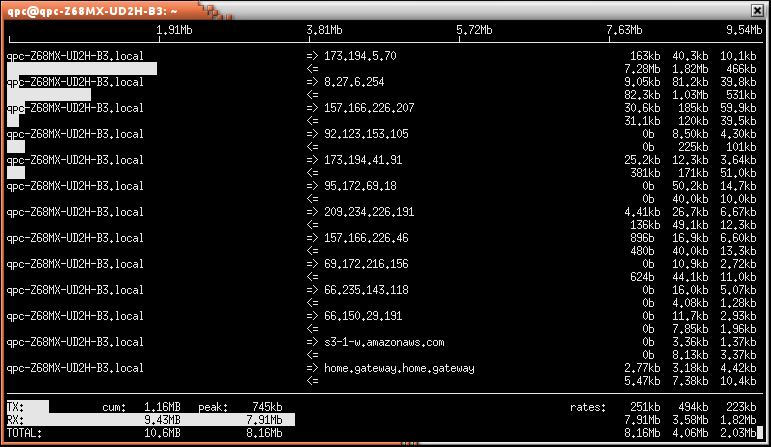iftop is an open source utility that displays bandwidth usage on an interface by host. iftop does for network usage what top does for processor usage. This utility listens to network traffic on a named interface and displays a table of current bandwidth usage by pairs of hosts.
iftop listens to network traffic on a named interface, or on the first interface it can find which looks like an external interface if none is specified, and displays a table of current bandwidth usage by pairs of hosts. iftop must be run with sufficient permissions to monitor all network traffic on the interface.
By default, iftop counts all IP packets that pass through the filter, and the direction of the packet is determined according to the direction the packet is moving across the interface.
When running, iftop uses the whole screen to display network usage. At the top of the display is a logarithmic scale for the bar graph which gives a visual indication of traffic.
Features include:
- View bandwidth usage distinguished by source-ip source-port destination-ip destination port.
- Filters.
- Linear bar graphs.
- Support for 802.1q VLANs.
- Support for “tun” interfaces.
- Supports both IPv4 and IPv6.
- Optional removal of the shell escape function.
- Optional fixed bandwidth limits.
- Monitor and display only specific host interface, host source, IP address, IP network block, destination host, bandwidth exceed limit, filter rules, bandwidth rate, bandwidth usage summary, sorting order.
- Option to run iftop in promiscuous mode, so that traffic which does not pass directly through the specified interface is also counted.
- Disable DNS lookups – resolving IPs can reduce performance of the tool and artifically change the traffic statistics.
- Show port data.
- Configuration file support.
Website: www.ex-parrot.com/pdw/iftop
Support: Mailing List
Developer: Paul Warren, Chris Lightfoot
License: GNU General Public License v2.0

iftop is written in C. Learn C with our recommended free books and free tutorials.
Return to Console Based Network ‘top’ Tools
| Popular series | |
|---|---|
| The largest compilation of the best free and open source software in the universe. Each article is supplied with a legendary ratings chart helping you to make informed decisions. | |
| Hundreds of in-depth reviews offering our unbiased and expert opinion on software. We offer helpful and impartial information. | |
| The Big List of Active Linux Distros is a large compilation of actively developed Linux distributions. | |
| Replace proprietary software with open source alternatives: Google, Microsoft, Apple, Adobe, IBM, Autodesk, Oracle, Atlassian, Corel, Cisco, Intuit, SAS, Progress, Salesforce, and Citrix | |
| Awesome Free Linux Games Tools showcases a series of tools that making gaming on Linux a more pleasurable experience. This is a new series. | |
| Machine Learning explores practical applications of machine learning and deep learning from a Linux perspective. We've written reviews of more than 40 self-hosted apps. All are free and open source. | |
| New to Linux? Read our Linux for Starters series. We start right at the basics and teach you everything you need to know to get started with Linux. | |
| Alternatives to popular CLI tools showcases essential tools that are modern replacements for core Linux utilities. | |
| Essential Linux system tools focuses on small, indispensable utilities, useful for system administrators as well as regular users. | |
| Linux utilities to maximise your productivity. Small, indispensable tools, useful for anyone running a Linux machine. | |
| Surveys popular streaming services from a Linux perspective: Amazon Music Unlimited, Myuzi, Spotify, Deezer, Tidal. | |
| Saving Money with Linux looks at how you can reduce your energy bills running Linux. | |
| Home computers became commonplace in the 1980s. Emulate home computers including the Commodore 64, Amiga, Atari ST, ZX81, Amstrad CPC, and ZX Spectrum. | |
| Now and Then examines how promising open source software fared over the years. It can be a bumpy ride. | |
| Linux at Home looks at a range of home activities where Linux can play its part, making the most of our time at home, keeping active and engaged. | |
| Linux Candy reveals the lighter side of Linux. Have some fun and escape from the daily drudgery. | |
| Getting Started with Docker helps you master Docker, a set of platform as a service products that delivers software in packages called containers. | |
| Best Free Android Apps. We showcase free Android apps that are definitely worth downloading. There's a strict eligibility criteria for inclusion in this series. | |
| These best free books accelerate your learning of every programming language. Learn a new language today! | |
| These free tutorials offer the perfect tonic to our free programming books series. | |
| Linux Around The World showcases usergroups that are relevant to Linux enthusiasts. Great ways to meet up with fellow enthusiasts. | |
| Stars and Stripes is an occasional series looking at the impact of Linux in the USA. | |

How does the bar graph work at the top? it bounces all over the place from KB to GB and doesn’t seem to compare with total bandwidth usage.
In fact nload, nethogs, iptraf all suck. Is there no single tool that can just tell us current total network utilization on all interfaces and utilization over a period of time.